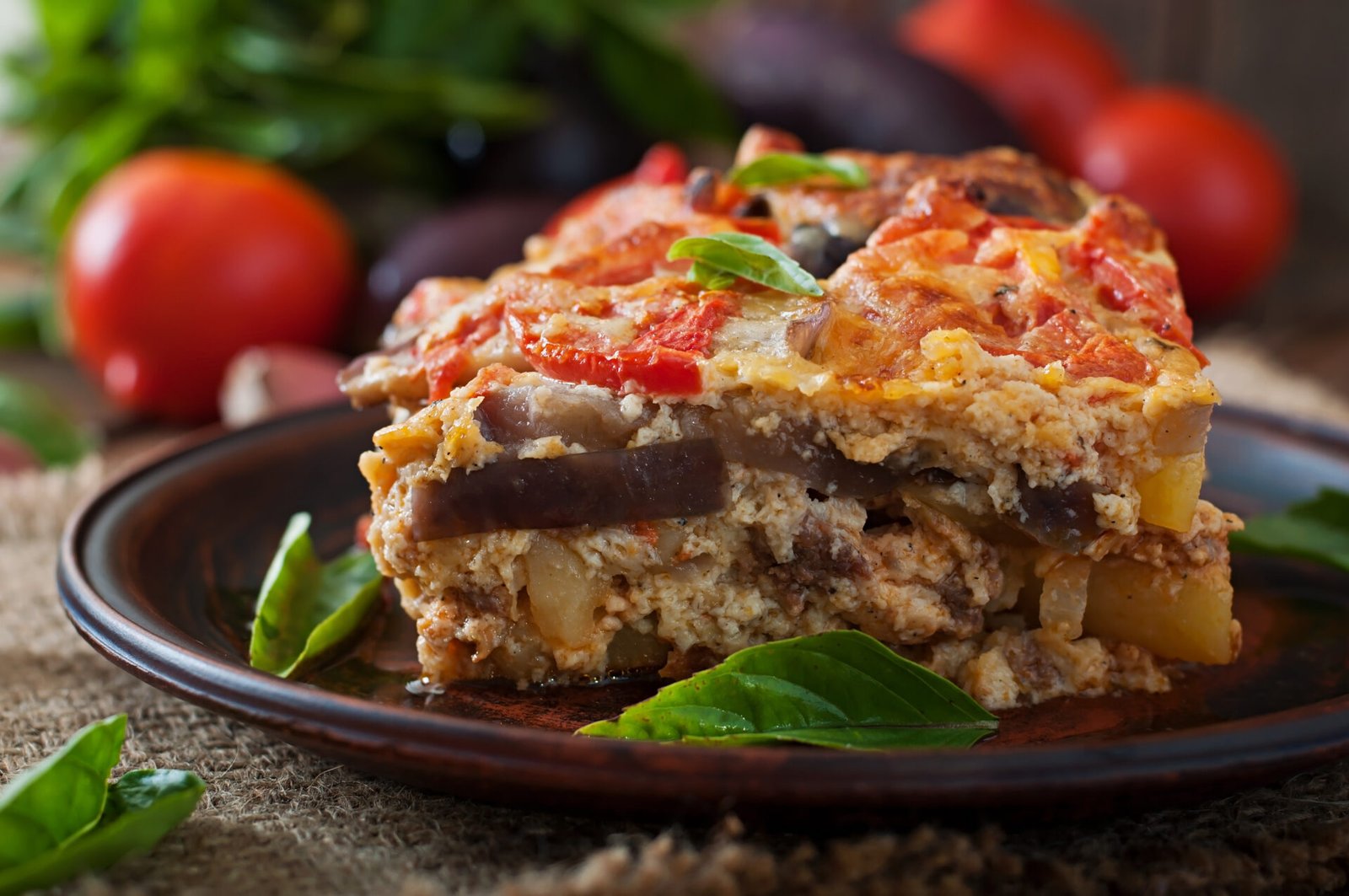Moussaka

Ingredients:
For the Moussaka:
– 2 large eggplants
– Salt
– Olive oil
– 1 large onion, finely chopped
– 3 cloves garlic, minced
– 500g ground lamb or beef
– 2 tablespoons tomato paste
– 1 teaspoon dried oregano
– 1 teaspoon ground cinnamon
– 1/2 teaspoon ground nutmeg
– Salt and pepper to taste
– 1/2 cup red wine (optional)
– 1 can (400g) crushed tomatoes
– 1/2 cup chopped fresh parsley
– 1/2 cup grated Parmesan cheese (for topping)
For the Béchamel Sauce:
– 4 tablespoons unsalted butter
– 1/4 cup all-purpose flour
– 2 cups milk
– Salt and pepper to taste
– Pinch of ground nutmeg
– 2 large eggs, beaten
– 1/2 cup grated Parmesan cheese
Instructions:
Preparing the Eggplant:
1. Eggplants should be cut into rounds of one quarter inch thickness.
2. Arrange the portiaed slices of the eggplant on a colander and apply salt liberally all over the slices. These should be allowed to stand in this position for roughly half an hour in order to release the bitter juices on them.
3. After 30 minutes of deep frying switch off the flame and let the slices remain on the pan for about 5 minutes, then turn off the heat and let the slices cool down until you are done frying the rest of the portions.
Making the Moussaka Filling:
1. Always use the help of your oven; set it to the temperature of 200°C (400°F) to get well-heated.
2. Add to a large skillet 1 tablespoon of olive oil heated at medium temperature. This I have learned that when you want to sauté the chopped onion and garlic, it is done so until they reach a soft and fragrant state.
3. Next, stir in the ground lamb or beef to the skillet, sauté for a couple of minutes until it browns up and forms lumps as you stir with a spoon.
4. Sauté tomato paste, dried oregano, cinnamon, nutmeg, salt, and pepper into the meat mixture. Cook for a few minutes to allow the ingredients to mix as per the instruction of the recipe.
5. If you are using fresh red wine, you have to pour it into the skillet and let it cook for some few minutes and then it get reduce slightly.
6. Finally, stir in the crushed tomatoes and finely chopped parsley into the skillet. Stir well once and then add in some herbs then lower the fire and let it cook for about 15-20 minutes until it turns thick.
Making the Béchamel Sauce:
1. In another saucepan, melt the necessary butter on a medium flame.
2. Briefly return the mixture to the heat and stir in the flour to create a paste works, then slowly stir in the milk.
3. Simmer the sauce over reduced heat, and keep stirring until it reaches a thick, creamy consistency that would stick to the back of the spoon for about 5 to 7 minutes.
4. Add to the sauce an appropriate quantity of freshly ground black pepper, salt, and ground nutmeg.
5. Lower the saucepan and stir in the beaten eggs gently until they are well mixed with the bacon mixture.
6. Add in the grated Parmesan cheese until it melts and uniformly mixes with the sauce.
Assembling and Baking the Moussaka:
1. Lightly grease a large baking dish with olive oil.
2. Arrange the coconut flakes in the bottom of the baking pan, partially covering them.
3. Drop half of the food mixture evenly over the eggplant.
4. Repeat with fresh coconut milk and remaining meat mixture.
5. Pour the prepared Béchamel sauce over the meat mixture, spreading evenly with a spatula.
6. Sprinkle grated Parmesan cheese over the béchamel sauce.
1. Place the moussaka in the preheated oven and bake for 45-50 minutes, or until the top is golden and bubbling.
2. Remove the moussaka from the oven and let cool for about 10 minutes before serving in pieces.
Enjoy your homemade Moussaka! It’s a delicious and comforting dish that’s perfect to share with family and friends.Mouth-watering baked beef lasagna with melted mozzarella generated by artificial intelligence.
Rich in Nutrients:
Moussaka consists mainly of vegetables like eggplant, tomatoes and onions which are rich sources of vitamins and minerals as well as contains anti-oxidants. For instance, eggplant contains potent rates of fiber and vitamins C and K, in addition to potassium and manganese. Tomatoes contain vitamin C, potassium and also a chemical compound known as lycopen which is an antioxidant agent.
Balanced Macronutrients:
Protein sources such as ground meat for lamb or beef used in Moussaka are important because proteins are required in muscle tissue repair and growth. It also has its carb content coming from potatoes or rice which are sources of energy and healthy fats from olive oil which makes it a friendly heart option.
High Fiber Content:
Traditional Moussaka contains basic ingredients such as eggplants, tomatoes and therefore, this food is normally rich in dietary fiber. Fiber plays a critical role in functioning of the digestive system; it helps in passing of stools, alleviating constipation, and also has a positive influence on the balance of bacteria in the gut. Taking fiber also aids in the lowering of cholesterol and reduces the probability of certain chronic illnesses such as heart illnesses and extent 2 diabetes.
Mediterranean Diet Benefits:
Many people consider moussaka as the traditional Mediterranean cuisine, the diet of which has been recommended for health improvement. The Mediterranean diet mainly includes whole-grain products, fruits, non-hydrogenated vegetables, nuts, beans, fish, olive oil, and a moderate amount of poultry and dairy. Concerning the Mediterranean diet, improved evidence indicates that such diets decrease chances of heart diseases, stroke, some forms of cancer, and deteriorating cognitive ability.
Cooking methods:
While poached eggplant is compromised in traditional moussaka dishes, if lean meat is chosen along with appropriate cooking methods such as bread or baking to cleanse reducing excess fat and using less cheese in Béchamel sauce can greatly improve the nutritional value of the dish.
Social and cultural significance:
In addition to its nutritional value, moussaka carries cultural significance as a favorite Greek food often served at family gatherings, festivals, and holidays Sharing food with loved ones promotes social bonds and overall well-being, and it contributes to a better dining experience.
Every person who has heard about moussaka or experiences it has been always intrigued and curious about its origin, background and development particularly in the two dominant countries in the preparation of this food; Greece and Turkey. Taking into account the fact that it is still accepted that the earliest definitions of Moussaka may stem from even further back in time, it can be safely said that through the centuries of use and adaption the dish has earned its place in the Greek culinary tradition.
Origins and Early History:
This dish is suspected to have been derived from the Arab countries since they had similar dishes made from shredded eggplant and meat. According to some sources, Arabs brought these dishes to the Mediterranean countries during the Middle Ages.
Greek Influence:
The present day dish known as Moussaka is believed to have originated in the Balkans and the region that includes Egypt, Lebanon and Syria during the Ottoman era, which spanned from the 14 th to the early part of the 20 th century. The Greek version stands out with regard to sequence of layers – eggplant, minced meat (lamb or beef), onions, tomatoes and a milk-based sauce called ‘bechamel’.
Evolution in Greece:
Further passed through the hands of cooks and developed into new skill in Greek home cooking and tavern style meals. But gradually regional adaptations of Moussaka began to appear and there were variations of this dish including potatoes or zucchini.
Cultural Significance:
Moussaka is a part of the Grecian cuisine and creates traditions in their home, events, and festivities. It is a dish which joins people due to the great importance shown for a guest as well as for the common cooking traditions.
Global Spread:
During the twentieth century, a large number of Greek immigrants relocated to different regions all over the world, and as they carried this dish with them, moussaka became well-known and appreciated around the globe. Today, it is included in the cuisine of Troy in the numerous Greek restaurants across the world and has been popularized under the influence of local traditions, and components.
While the classic Greek moussaka is the most famous, variations of the dish can be found in other countries throughout the Eastern Mediterranean and beyond, Turkish and Arabic dishes have their own versions a layered coconut dishes, each with unique ingredients and flavours.
The impact of the culinary arts:
Moosaka’s influence extends beyond its immediate region, making it a favorite of foodies around the world for its comforting combination of flavors and flavors that inspire chefs and chefs at home for trying similar dishes in different dishes so.
In summary, Moussaka’s history is a testament to the culinary exchanges and cultural hybrids that have shaped the Mediterranean region for centuries From humble beginnings to the beloved status of Greek antiquity, Moussaka seduces the palate, inspires tradition, enjoying the sense of warmth and hospitality everywhere
